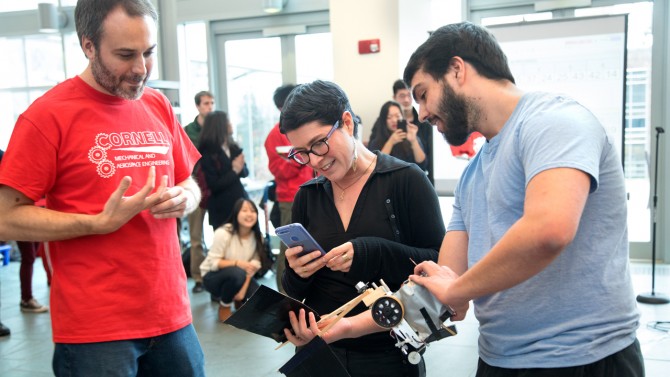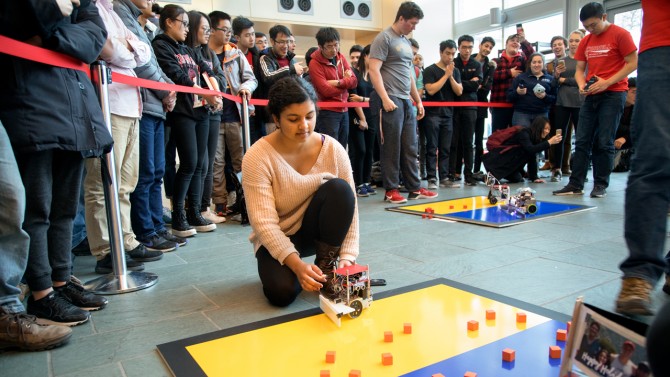New Mechatronics final project has students, robots going cube crazy
By Tom Fleischman
After nearly a decade of the same old final project – a robot sumo wrestling competition – professor Hadas Kress-Gazit thought it was time that her junior-level Mechatronics class switched things up a bit.
“We kind of got tired of seeing the same things again and again,” she said. “I mean, [sumo] was amazing, but people stopped innovating.”
Last spring, three of her students were tasked with coming up with new ideas for the final project, which incorporates all of the electronics and software/algorithm elements the course teaches. And of the three, it was Laura Lee ’18 whose idea became the latest Mechatronics “craze.”
On Dec. 1, approximately 150 students and 49 robots gathered in Duffield Hall atrium to take part in the inaugural Cube Craze competition. And judging by the students and professors looking on from the second- and third-floor balconies, as well as scores of team members huddled around the cordoned-off competition area, Cube Craze was an unqualified success.
Students had approximately three weeks to design and build autonomous robots, whose objective was to move 1-inch-square wooden blocks onto their opponent’s half of a 4-foot-square, two-colored field. Each robot started with 10 blocks on its half; each game lasted 60 seconds.
The winning robot – named “Jeffrey” – came from the trio of Marissa Polack ’19, Mabel Lawrence ’19 and Harrison Fay ’19. Their victory in the best-of-three final – over a robot named “Blocktimus Prime” – was a bit unexpected, they said.
“It was surprising, because it wasn’t working last night,” Polack said. “We were having a lot of issues, but today it didn’t have any of the issues it had been having, which was nice.”
“The sensors tended to be very unreliable,” Fay said. “You would adjust the sensors a tiny bit, and then they would start working. Then you would adjust them a little more, and they would stop working. I guess, at the very last second, we figured it out.”
Dutch company ASML, a world leader in computer chip-making equipment, sponsors Kress-Gazit’s class as well as the final project. Ken Bogursky ’96, senior manager of mechanical development in the company’s Wilton, Connecticut, office, said the company partners with several top universities but its connection to Cornell is strongest.
“That’s because the school has such a great engineering program,” Bogursky said. “We have a lot of mechanical and electrical engineers, some software engineers from Cornell,” adding that approximately 25 of the 150 engineers in his department went to Cornell.
Bogursky praised the change in competition, which included the ASML robot (“Scrooge”) taking on the champion in a best-of-three challenge.
“This is our fifth year sponsoring the competition,” he said, “and we’ve sort of passed on the tribal knowledge from one year to the next. Last year, the ASML robot just completely dominated the Cornell robot to the fact that we got booed, which is not really what we’re going for.”
The Duffield atrium was abuzz during the competition. Competitors and other onlookers jockeyed for position along the rope, inside of which were six playing fields. Each new round of competition was initiated with a hand-held gong, usually sounded by one of the teaching assistants, who also served as referees.
Students were limited by size and budget, but the methods for victory were limited only by the imagination.
“We saw lots of ideas, a lot of different ways to think about it,” said TA Drew Mitchner ’18, who competed last year. “You’re using electrical, mechanical ideas, just kind of creative brainstorming.”
The winners’ idea was ingenious: Their robot had plowlike devices on three sides that were painted black – the same color as the field’s 3-inch black border. Most teams’ robots would stop when their sensors detected that border, so the winners’ plows had that same effect.
“We beat a bunch of other teams that way,” Fay said, “by basically stalling them when they saw the black.”
“Jeffrey” was bested by the ASML entry in their post-competition exhibition, but defeated the TA entry.
Lee, who came up with the idea for Cube Craze, was happy with how her brainchild turned out.
“I wanted to see more mechanical innovation, software, algorithms,” she said, “and this is what came out of that.”
Media Contact
Get Cornell news delivered right to your inbox.
Subscribe
